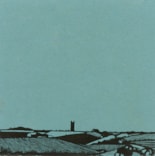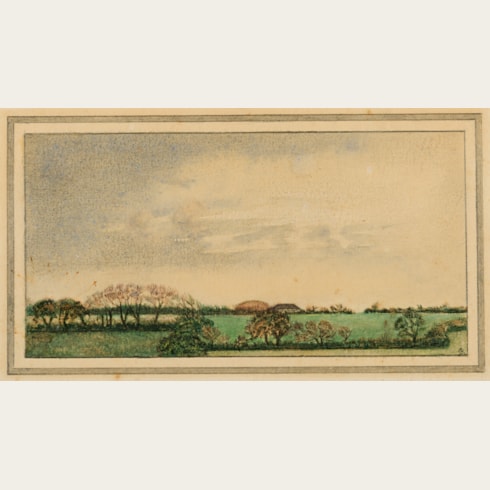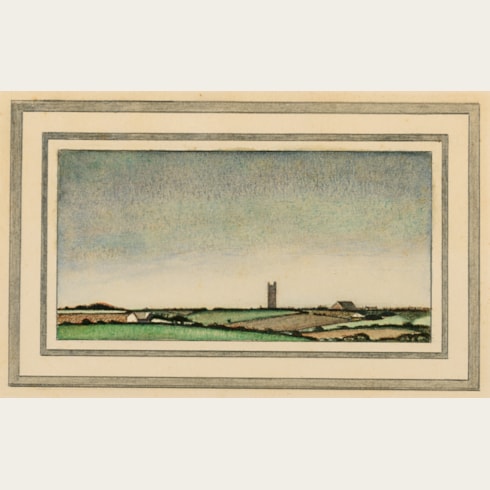GLUCK
(London 1895 - Steyning 1978)
Landscape with a Church Tower
Sold
Black ink and black wash on blue paper.
126 x 126 mm. (5 x 5 in.)
126 x 126 mm. (5 x 5 in.)
It was in her early years as an artist in Lamorna in Cornwall that Gluck first developed an abiding love of landscape. Her landscape compositions were almost always characterized by a large expanse of sky above a very low horizon. In some unpublished ‘Notes on Landscape Painting’, written in 1940, she recalled of the work she produced in Cornwall: ‘My landscapes were the first that truthfully showed the immediate impression one gets there – that of very little land and great expanses of sky...The sky is a bowl, not a flat backcloth and its colour and light reflect in every blade of grass, every twig…the colour of the sky permeates the landscape under that sky…Wind and weather change continuously, a landscape is chameleon to the light.’ Gluck kept a studio at Lamorna until 1947, and in 1953 acquired a cottage in the nearby village of St. Buryan.
Although it is often difficult to date the artist’s landscapes, or to identify their exact location, the present sheet is very closely related to a small Cornish landscape painting of 1964, today in a private collection, in which an identical church tower – probably the late 15th century parish church of St. Buryan - appears on the horizon.
Arnold Hunt owned another work by Gluck, a small, undated Cornish Landscape, painted on panel and measuring 12.3 x 18.1 cm.
Although it is often difficult to date the artist’s landscapes, or to identify their exact location, the present sheet is very closely related to a small Cornish landscape painting of 1964, today in a private collection, in which an identical church tower – probably the late 15th century parish church of St. Buryan - appears on the horizon.
Arnold Hunt owned another work by Gluck, a small, undated Cornish Landscape, painted on panel and measuring 12.3 x 18.1 cm.
Born into a wealthy Jewish family in London, as a teenager Hannah Gluckstein rebelled against her conservative upbringing, cutting her hair, dressing in men’s clothes and rejecting her given name, eventually insisting on being referred to simply as ‘Gluck’. She attended the St. John’s Wood Art School and on a visit to the artist’s colony of Lamorna in southwest Cornwall befriended the painters Alfred Munnings, Samuel John ‘Lamorna’ Birch and Laura and Harold Knight, who encouraged her in her desire to become an artist. As a result, she left her family home in London for good, and returned to work at Lamorna Cove. She came to love Cornwall and kept a studio there throughout her life. One early supporter was the department store magnate Gordon Selfridge, who set up a studio within his store for Gluck to paint portraits in one sitting, although she soon abandoned this as she felt it was making her work too slick, and also because she always preferred to choose her own subjects.
Over the course of her career, Gluck painted landscapes, theatrical scenes, exquisite floral still lives and, especially, a series of superb and stylish portraits. She worked very slowly, and chose to only have one-man exhibitions, refusing to take part in group shows. Her first solo exhibition was held at the Dorien Leigh Galleries in 1924, arranged by one of her first supporters, the photographer E. A. Hoppé, and all sixty works in the show were sold. A second exhibition of forty-four works was mounted at the Fine Art Society in 1926, and again met with much critical and commercial success. Around the same time Gluck moved into a large house in Hampstead and had a modern and airy studio built in the garden. She lived there with her lover, the society florist Constance Spry, whose work inspired Gluck to begin painting the large flower compositions for which she became well known. For her next exhibition in 1932, she transformed the galleries of the Fine Art Society into a ‘Gluck room’, decorated with wall panels and pilasters in a muted colour scheme to create a harmonious arrangement of interior decoration. She also had her paintings framed in a special white, three-stepped frame of her own patented design, which came to be known as the Gluck frame, and was used for all her work from then on. The exhibition of twenty-nine paintings, including eleven of flowers, was again a huge triumph, and was followed by another equally successful show of thirty-three pictures in 1937.
In between these two exhibitions Gluck met the one great love of her life, the socialite and philanthropist Nesta Obermer, with whom she was to have an intense relationship until 1944, and who remained a lifelong friend. After the 1937 exhibition, Gluck spent most of her time travelling with Nesta and seems to have only completed one painting - a commissioned portrait -before the outbreak of the Second World War, which destroyed the world of high society and style that she had flourished in. Her London home was requisitioned by the Auxiliary Fire Service and to be near Nesta she moved to a small house in Plumpton in East Sussex, where she began working on portrait commissions. However, she also began suffering from what seems to have been panic attacks which prevented her from being very productive. Her relationship with Nesta also began to suffer, and in 1944 Gluck moved to the Chantry House in the West Sussex town of Steyning, the home of the sisters and journalists Nora and Edith Shackleton Heald. The latter was to become the artist’s longtime partner, and Gluck lived with her at the Chantry House for the rest of her life. She painted relatively little, compared to her life in London before the war, and instead focussed her attention, for more than a decade, on a personal campaign to improve the quality of fine artist’s materials and establish a recognized British standard for them.
She did not exhibit her work in public in London for over thirty-five years, until a retrospective exhibition at the Fine Art Society in 1973, which included mainly works from the 1920s and 1930s, along with some recent paintings. Despite the huge success of the exhibition, Gluck suffered from poor health and was unable to work again. She died in January 1978, at the age of eighty-two, and a memorial exhibition was held at the Fine Art Society in the winter of 1980.
Over the course of her career, Gluck painted landscapes, theatrical scenes, exquisite floral still lives and, especially, a series of superb and stylish portraits. She worked very slowly, and chose to only have one-man exhibitions, refusing to take part in group shows. Her first solo exhibition was held at the Dorien Leigh Galleries in 1924, arranged by one of her first supporters, the photographer E. A. Hoppé, and all sixty works in the show were sold. A second exhibition of forty-four works was mounted at the Fine Art Society in 1926, and again met with much critical and commercial success. Around the same time Gluck moved into a large house in Hampstead and had a modern and airy studio built in the garden. She lived there with her lover, the society florist Constance Spry, whose work inspired Gluck to begin painting the large flower compositions for which she became well known. For her next exhibition in 1932, she transformed the galleries of the Fine Art Society into a ‘Gluck room’, decorated with wall panels and pilasters in a muted colour scheme to create a harmonious arrangement of interior decoration. She also had her paintings framed in a special white, three-stepped frame of her own patented design, which came to be known as the Gluck frame, and was used for all her work from then on. The exhibition of twenty-nine paintings, including eleven of flowers, was again a huge triumph, and was followed by another equally successful show of thirty-three pictures in 1937.
In between these two exhibitions Gluck met the one great love of her life, the socialite and philanthropist Nesta Obermer, with whom she was to have an intense relationship until 1944, and who remained a lifelong friend. After the 1937 exhibition, Gluck spent most of her time travelling with Nesta and seems to have only completed one painting - a commissioned portrait -before the outbreak of the Second World War, which destroyed the world of high society and style that she had flourished in. Her London home was requisitioned by the Auxiliary Fire Service and to be near Nesta she moved to a small house in Plumpton in East Sussex, where she began working on portrait commissions. However, she also began suffering from what seems to have been panic attacks which prevented her from being very productive. Her relationship with Nesta also began to suffer, and in 1944 Gluck moved to the Chantry House in the West Sussex town of Steyning, the home of the sisters and journalists Nora and Edith Shackleton Heald. The latter was to become the artist’s longtime partner, and Gluck lived with her at the Chantry House for the rest of her life. She painted relatively little, compared to her life in London before the war, and instead focussed her attention, for more than a decade, on a personal campaign to improve the quality of fine artist’s materials and establish a recognized British standard for them.
She did not exhibit her work in public in London for over thirty-five years, until a retrospective exhibition at the Fine Art Society in 1973, which included mainly works from the 1920s and 1930s, along with some recent paintings. Despite the huge success of the exhibition, Gluck suffered from poor health and was unable to work again. She died in January 1978, at the age of eighty-two, and a memorial exhibition was held at the Fine Art Society in the winter of 1980.
Provenance
A gift to the artist to Arnold Hunt
Thence by descent.
Thence by descent.






